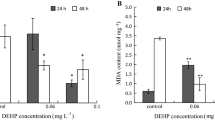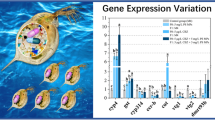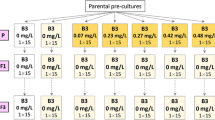Abstract
Tritan™ copolyester is a novel plastic form from Eastman Company utilizing three main monomers, 1,4-cyclohexanedimethanol (CHDM), dimethyl terephthalate (DMT), and 2,2,4,4-tetramethyl-1,3-cyclobutanediol. Despite Tritan™ has been widely applied for plastic bottles, the effects of long-term exposure to these compounds have seldom been investigated. We investigated chronic effects and endocrine disruption potential of CHDM and terephthalic acid (TPA), main mammalian metabolite formed from DMT, using crustacean Daphnia magna and Moina macrocopa, and freshwater fish (Oryzias latipes). The effects on sex hormone balance and the associated mechanisms were also investigated by use of H295R cells. In chronic toxicity test, D. magna showed significant decrease in reproduction (number of young per female) after exposure to 10 mg/L TPA. In early life stage exposure using O. latipes, significant decrease of juvenile survival and weight were observed in fish exposed to 10 mg/L and ≥1 mg/L CHDM, respectively. Expressions of vtg2 mRNA in fish exposed to CHDM and those of cyp19b, star, cyp17, and cyp19a mRNAs in fish exposed to TPA were significantly up-regulated. The results of H295R cell assay also showed that both chemicals at high concentrations could alter sex hormone production in steroidogenic pathway. The effective concentrations of the tested compounds were several orders of magnitude greater than the concentrations can be detected in ambient waters. Further in vivo and in vitro studies will be needed to investigate the effect of co-polymer on endocrine disruption.




Similar content being viewed by others
References
Allen WO, Gerald AL (2000) Effects of endocrine-active chemicals on the development of sex characteristics of Daphnia magna. Environ Toxicol Chem 19:2107–2113
Bittner G, Yaniger S et al (2012) Comment on “Lack of androgenicity and estrogenicity of the three monomers used in Eastman’s Tritan™ copolyesters” by Osimitz et al. Food Chem Toxicol 50:4236–4237
Chemical Safety Report (2010) Terephthalic acid. CSR
Chemical Safety Report (2013). CHDM_Eastman. CSR-PI-5.4.0
Dodson S, Hanazato T (1995) Commentary on effects of anthropogenic and natural organic chemicals on development, swimming behavior, and reproduction of Daphnia, a key member of aquatic ecosystems. Environ Health Perspect 103:7–11
European Commission (2011) Commission directive 2011/8/EU of 28 January 2011 on the restriction of use of Bisphenol A in plastic infant feeding bottles. http://eur-lex.europa.eu/LexUriServ/LexUriServ.do?uri=OJ:L:2011:026:0011:0014:EN:PDF. Accessed 17 Feb 2014
Goodman JE, Witorsch RJ, McConnell EE, Sipes IG, Slayton TM, Yu CJ (2009) Weight-of-evidence evaluation of reproductive and developmental effects of low doses of Bisphenol A. Crit Rev Toxicol 39:1–75
Hecker M, Newsted JL, Murphy MB, Higley EB, Jones PD, Wu RS, Giesy JP (2006) Human adrenocarcinoma (H295R) cells for rapid in vitro determination of effects on steroidogenesis: hormone production. Toxicol Appl Pharmacol 217:114–124
Heugens EHW, Tokkie LTB, Kraak MHS, Hendriks AJ, van Straalen NM, Admiraal W (2006) Population growth of Daphnia magna under multiple stress conditions: joint effects of temperature, food, and cadmium. Environ Toxicol Chem 25:1399–1407
Hilscherova K, Jones PD, Gracia T, Newsted JL, Zhang X, Sanderson JT, Yu RM, Wu RS, Giesy JP (2004) Assessment of the effects of chemicals on the expression of ten steroidogenic genes in the H295R cell line using real-time PCR. Toxicol Sci 81:78–89
Ishibashi H, Watanabe N, Matsumura N, Hirano M, Nagao Y, Shiratsuchi H, Kohra S, Yoshihara S, Arizono K (2005) Toxicity to early life stages and estrogenic effect of a Bisphenol A metabolite, 4-methyl-2,4-bis(4-hydroxyphenyl)pent-1-ene on the medaka (Oryzias latipes). Life Sci 77:2643–2655
Ji K, Choi K, Lee S, Park S, Khim JS, Jo EH, Choi K, Zhang X, Giesy JP (2010) Effects of sulfathiazole, oxytetracycline and chlortetracycline on steroidogenesis in the human adrenocarcinoma (H295R) cell line and freshwater fish Oryzias latipes. J Hazard Mater 182:494–502
Kime DE (1998) Disruption in eggs, embryos, larvae and juvenile fish. In: Kime DE (ed) Endocrine disruption in fish. Kluwer Academic Publishers, Boston, pp 187–200
Livak JK, Schmittgen TD (2001) Analysis of relative gene expression data by use of real-time quantitative PCR and the 2ΔΔC(T) method. Methods 25:402–408
Organization for Economic Cooperation and Development (1992) OECD Guideline for testing of chemicals, test No. 210: Fish, early-life stage toxicity test. Paris, France
Organization for Economic Cooperation and Development (2009) The 2007 OECD List of High Production Volume Chemicals. ENV/JM/MONO 40. OECD. Paris, France 23 October 2009. http://search.oecd.org/officialdocuments/displaydocumentpdf/?cote=env/jm/mono(2009)40&doclanguage=en Accessed 18 Feb 2014
Organization for Economic Cooperation and Development (2012) OECD Guideline for testing of chemicals, test No. 211: Daphnia magna reproduction test. Paris, France
Oh S, Choi K (2012) Optimal conditions for three brood chronic toxicity test method using a freshwater macro invertebrate Moina macrocopa. Environ Monit Assess 184:3687–3695
Osimitz TG, Eldridge ML, Sloter E, Welsh W, Ai N, Sayler GS, Menn F, Toole C (2012) Lack of androgenicity and estrogenicity of the three monomers used in Eastman’s Tritan™ copolyesters. Food Chem Toxicol 50:2196–2205
Sumpter JP, Jobling S (1995) Vitellogenesis as a biomarker for estrogenic contamination of the aquatic environment. Environ Health Perspect 103(Suppl 7):173–178
US Environmental Protection Agency (2002) Method for measuring the acute toxicity of effluents and receiving waters to freshwater and marine organisms. EPA/6004-90/027F. Washington, DC
US Environmental Protection Agency (2010) Office of pollution prevention and toxics. ChemRTK 1990 HPV challenge program chemicals list. http://www.epa.gov/chemrtk/pubs/update/hpv_1990.htm. Accessed 18 Feb 2014
WIL Research Laboratories (2008) A Hershberger assay of 2,2,4,4-tetramethyl-1,3-cyclobutanediol, dimethyl terephthalate and 1,4-cyclohexanedimethanol administered orally in peripubertal orchidoepididyectomized rats. Study No. WIL-387012 sponsored by Eastman Chemical Company, completion date 25 Nov 2008
WIL Research Laboratories (2009) A uterotrophic assay of 2,2,4,4-tetramethyl-1,3-cyclobutanediol, dimethyl terephthalate and 1,4-cyclohexanedimethanol administered orally in ovariectomized rats. Study No. WIL-387013 sponsored by Eastman Chemical Company, completion date January 26, 2009
Yang C, Yaniger S, Jordan VC, Klein D, Bittner G (2011) Most plastic release estrogenic chemicals: a potential health problem that can be solved. Environ Health Perspect 119:989–996
Yokota H, Tsuruda Y, Maeda M, Oshima Y, Tadokoro H, Nakazono A, Honjo T, Kobayashi K (2000) Effect of Bisphenol A on the early life stage in Japanese medaka (Oryzias latipes). Environ Toxicol 19:1925–1930
Zhang XX, Sun SL, Zhang Y, Wu B, Zhang ZY, Liu B, Yang LY, Cheng SP (2010) Toxicity of purified terephthalic acid manufacturing wastewater on reproductive system of male mice (Mus musculus). J Hazard Mater 176:300–305
Zhang X, Chang H, Wiseman S, He Y, Higley E, Jones P, Wong CK, Al-Khedhairy A, Giesy JP, Hecker M (2011) Bisphenol A disrupts steroidogenesis in human H295R cells. Toxicol Sci 121:320–327
Acknowledgments
This study was supported by the research fund of Yongin University in 2013.
Conflict of interest
The authors declare that they have no conflict of interest.
Author information
Authors and Affiliations
Corresponding author
Electronic supplementary material
Below is the link to the electronic supplementary material.
Rights and permissions
About this article
Cite this article
Jang, S., Ji, K. Effect of chronic exposure to two components of Tritan™ copolyester on Daphnia magna, Moina macrocopa, and Oryzias latipes, and potential mechanisms of endocrine disruption using H295R cells. Ecotoxicology 24, 1906–1914 (2015). https://doi.org/10.1007/s10646-015-1526-5
Accepted:
Published:
Issue Date:
DOI: https://doi.org/10.1007/s10646-015-1526-5




